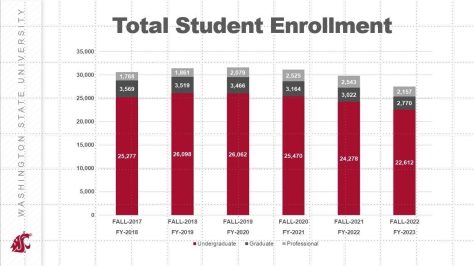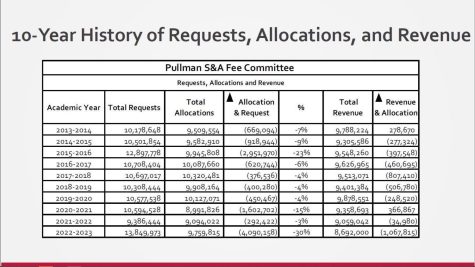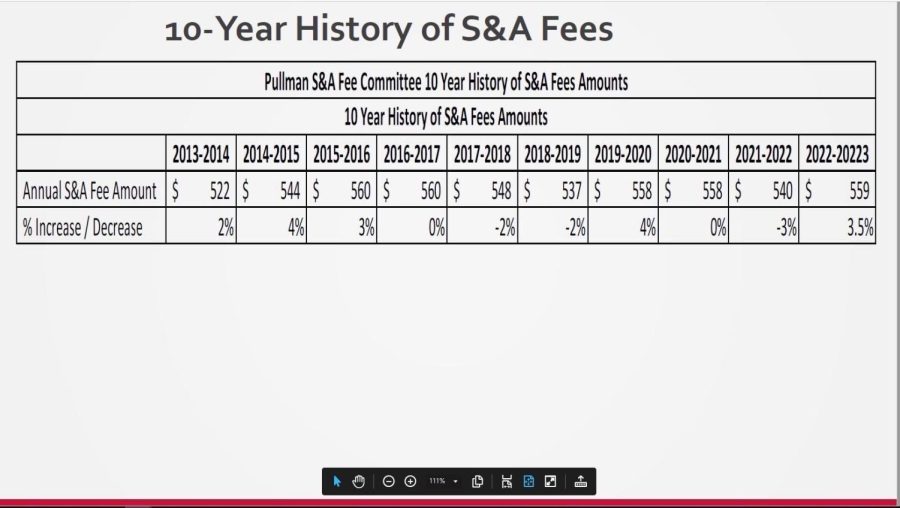Services and Activities Fee allocation cut substantially for 2023–24 school year
With enrollment down, there is less money to go out
S&A fees go to non-academic student programs.
April 27, 2023
Next year, Services and Activities Fee allocations to individual groups are being reduced, said Matt Skinner, interim CFO at WSU.
Meanwhile, the fee paid per student will increase by 3.5%, with the official number not being confirmed yet, he said. S&A fees go to non-academic student programs like the Compton Union Building, ASWSU, Graduate and Professional Student Association, Student Entertainment Board, University Recreation programming and transit, according to the WSU website.
Only the student-led S&A fee committee has the authority to change the S&A fee amount or how much funds are allocated, Skinner said. With enrollment falling since 2020, less revenue is available for the S&A fee committee to be able to give out to groups requesting funding.

“The enrollment during fiscal year 2020 hit the high of where we’ve been. And since that time now for [this academic year], enrollments are down about 12%,” he said. “Since there’s fewer students attending, there’s fewer S&A funds being generated. That’s what we’re seeing in the Pullman S&A fee revenue side; that their revenue are down about 12%.”
The S&A fee committee had to make “difficult” decisions to reduce funding because of reduced revenue and increased requests for funding, Skinner said. The committee is thoughtful about the funds they have and how to support a majority of students.
The likely reason the fee is increasing while allocations are lower is to generate additional funding, he said. The funding generated by the rate increase allowed the allocation reductions to be less than they would have been if the fees stayed the same.
The recommendation to reduce S&A allocations is being forwarded to the Board of Regents the first week of May, Skinner said. In the past, the board has always been supportive of and followed the recommendation of the S&A fee committee. After the Board of Regents meets, the decision will be finalized.

In the past 10 years, the S&A fee change has ranged from decreasing by 3% to increasing by 4%, according to graphs from Finance and Administration. This year, there were $13.8 million in S&A requests and around $9.8 million in allocations. Comparatively, the 2021 school year had $9.4 million in S&A requests and $9.1 million in allocations.
The amount of revenue from S&A fees this school year was $8.7 million, according to graphs from Finance and Administration, resulting in $1.1 million being spent above existing revenue. The money that was allocated beyond revenues came from the one-time reserves, Skinner said.
Matt Shaw, associate director at the Center for Student Organizations and Leadership, said that Student Engagement Services rely on S&A fees for staffing and many programs. SES advises groups like ASWSU, GPSA and SEB and puts on events like Cougs Lead.
While the cuts are not helpful, student groups will figure out how to do more with less, Shaw said.
“I also am confident in our students and confident that the departments and the programs that we offer at the university, that we can be creative and students can be creative and can still put on really great programs and really provide great opportunities for students,” he said.
While some effects of the cuts are known now, like staffing, other effects will not be known until midway through the next year, Shaw said. While the cost of programs and goods and services can be planned for, their actual cost will not be known until they happen.
Some student groups are not happy with the cuts. The Crimson Group, a student group which provides support for undocumented students, presented their concerns to ASWSU on April 19. While the Crimson Group requested a budget of $23,000 next year, they were only allocated $13,000.
Carlos Rojo, senior political science major and co-chair of the Crimson Group, said that with less money the group will not be able to pay for as many Deferred Action for Childhood Arrivals renewals for students.
DACA is a policy that allows certain undocumented individuals who entered the US as children a work authorization and protection from deportation, Rojo said. Individuals have to renew their DACA status every one to two years and the renewal costs around $500.
“With the cut essentially what it means is that we would still be doing more fundraising,” he said. “But to put into perspective, the $23,000 which we originally had would have helped … around 50 students with DACA renewals. With the budget cut, it would now help around 20.”
Rojo said collective action is needed to change the budget cuts and it is important to support all student initiatives. The larger issue is that funds should not be cut when “the money is there.”
While many programs will receive cuts, the payments to long-term debt for facilities are fixed annual amounts until the debt is paid off and cannot be reduced, Skinner said. The debts that S&A fees repay are for the playfields and the CUB.
It is important to note that the S&A fees are separate from the general university budget and the fees are never used for anything outside of S&A programs, he said.
When it comes to the general budget, the university did not run a deficit during COVID-19 because of emergency funds from the federal government, Skinner said. However, general expenses have gone up, causing budget worries.
“I don’t know if COVID is part of it. We do have some increased expenses, just general expenses that have gone up in the last few years,” he said. “And that certainly adds to the pressure. That it does cost more to provide services and instruction than it did a couple of years ago.”
Shaw said that he cannot predict what S&A fee allocations will look like in the long term because he does not know what enrollment will look like year to year. He hopes that in the future, S&A allocations will increase and SES will receive more money, but he can’t say for sure.
Students are not aware of all the programming that S&A fees support, he said.
“They pay into this account every semester and it’s to provide them with opportunities to engage and participate and do things with other students,” Skinner said. “I don’t know that they take full advantage of that.”









